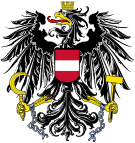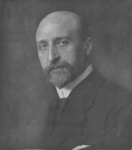1930 Austrian legislative election
Parliamentary elections were held in Austria on 9 November 1930.[1] The Social Democratic Workers' Party emerged as the largest faction in the National Council, with 72 of the 165 seats, but the Christian Social Party (with 66 seats) formed a new coalition government with Otto Ender as Chancellor. Voter turnout was 90%.[2]
This was the last parliamentary election to take place in the period of the First Austrian Republic. A series of socialist-fascist clashes in 1934 was followed by the authoritarian Federal State of Austria and eventual Anschluss in 1938 with Nazi Germany.
Results
 |
|---|
| Party | Votes | % | Seats | +/– |
|---|
| Social Democratic Workers' Party | 1,517,146 | 41.14 | 72 | +1 |
| Christian Social Party | 1,314,956 | 35.65 | 66 | – |
| National Economy Bloc (GDVP–LB) | 428,255 | 11.61 | 19 | – |
| Homeland Bloc | 227,401 | 6.17 | 8 | New |
| German National Socialist Workers' Party | 111,627 | 3.03 | 0 | 0 |
| Landbund for Austria | 43,689 | 1.18 | 0 | – |
| Communist Party of Austria | 20,951 | 0.57 | 0 | 0 |
| Austrian People's Party | 14,980 | 0.41 | 0 | New |
| Democratic Centre Party | 6,719 | 0.18 | 0 | New |
| Jewish List | 2,133 | 0.06 | 0 | New |
| Kaiser Loyalty People's Party | 157 | 0.00 | 0 | New |
| National Democratic Association | 54 | 0.00 | 0 | New |
| Total | 3,688,068 | 100.00 | 165 | 0 |
|
| Valid votes | 3,688,068 | 99.24 | |
|---|
| Invalid/blank votes | 28,098 | 0.76 | |
|---|
| Total votes | 3,716,166 | 100.00 | |
|---|
| Registered voters/turnout | 4,121,282 | 90.17 | |
|---|
| Source: Nohlen & Stöver |
Results by province
| Province
|
Votes
|
SDAPÖ
|
CS
|
GDVP–LB
|
HB
|
DNSAP
|
LB
|
KPÖ
|
ÖVP
|
DCP
|
JL
|
KLPP
|
NDA
|
|
|
|
|
|
|
|
|
|
|
|
|
|
|
|
|
%
|
%
|
%
|
%
|
%
|
%
|
%
|
%
|
%
|
%
|
%
|
%
|
| Vienna
|
1,192,672
|
58.98
|
23.72
|
10.43
|
2.21
|
2.31
|
0
|
0.89
|
0.71
|
0.56
|
0.18
|
0.01
|
0
|
| Lower Austria
|
818,302
|
35.63
|
44.13
|
8.58
|
6.62
|
4.2
|
0
|
0.5
|
0.34
|
0
|
0
|
0
|
0
|
| Upper Austria
|
479,285
|
28.37
|
45.42
|
7.29
|
8.29
|
2.41
|
7.71
|
0.25
|
0.27
|
0
|
0
|
0
|
0
|
| Salzburg
|
123,152
|
29.96
|
41.52
|
12.69
|
5.73
|
3.69
|
5.49
|
0.61
|
0.30
|
0
|
0
|
0
|
0
|
| Tyrol
|
176,843
|
21.99
|
54.97
|
12.34
|
9.28
|
1.24
|
0
|
0.17
|
0
|
0
|
0
|
0
|
0
|
| Vorarlberg
|
77,516
|
20.92
|
56.79
|
20.94
|
0
|
1.14
|
0
|
0.22
|
0
|
0
|
0
|
0
|
0
|
| Styria
|
510,164
|
34.38
|
32.52
|
16.51
|
12.48
|
3.42
|
0
|
0.39
|
0.31
|
0
|
0
|
0
|
0
|
| Carinthia
|
175,640
|
38.73
|
22.54
|
22.38
|
8.47
|
6.90
|
0
|
0.66
|
0.32
|
0
|
0
|
0
|
0
|
| Burgenland
|
134,494
|
37.75
|
41.23
|
16.01
|
3.80
|
0.75
|
0
|
0.47
|
0
|
0
|
0
|
0
|
0
|
| Total
|
3,688,068
|
41.14
|
35.65
|
11.61
|
6.17
|
3.03
|
1.18
|
0.57
|
0.41
|
0.18
|
0.06
|
0.00
|
0.00
|
| Source: Statistische Nachrichten : Sonderheft. Die Nationalratswahlen vom 9. November 1930, 12.[3]
|
References








